If you are new here, don’t forget to check our Discord Channel. it’s free for everyone!
If you would like to see more Living End content, including sideboard guide, click here.
Introduction
Living End is a combo deck that abuses the Cascade mechanic. The main game plan is to cast the namesake card with the help of three mana enablers in Shardless Agent or Ardent Plea. There are also versions that choose Bloodbraid Marauder, Press the Enemy or As Foretold, but they’re considered inferior by the majority of Living End players. We break the symmetry of Living End by filling our graveyard with expensive creatures, usually by cycling them. Evoke elementals like Grief or Subtlety also work well. On top of that, executing our gameplan usually disrupts the opponent, because they lose their board in the process. As a result, a resolved Living End creates both card and tempo advantage that’s usually enough to win the game shortly after.
The combination of high velocity from cyclers, reactive spells that can be cast for free in multiple spots, and both proactive and reactive nature of Living End, the deck is quite complicated to play. But thanks to all these angles of attack, it’s possible to adapt to nearly every situation you can face. This is one of the reasons why it remained a solid deck, even after the Violent Outburst ban.
A typical list
If you can’t see it or want a downloadable version, click here.
Why is it good? What is the best metagame for this deck?
There are a lot of reasons why you should play Living End. Because it’s a one-card combo with a lot of cantrips and versatile reactive spells to either protect your plan or disrupt the opponent’s, you’ll nearly always be able to execute your own gameplan. It’s a great deck in the creature-centric metagames, when what you normally do – putting a few big creatures onto the battlefield while killing your opponent’s board – is usually enough to end the game on the spot. Because the combo only requires one card, Living End can play a lot of interactive spells, so it’s possible to switch gears and act as control if necessary. It’s also good against spell-based combo decks, because of how good Grief and Force of Negation can be in those matchups.
What are the deck’s biggest weaknesses?
There are a few things I fear when playing Living End. The first one is the dedicated hate. Because the deck uses graveyard, it can be stopped by a plethora of things: Relic of Progenitus, Nihil Spellbomb, Endurance, Dauthi Voidwalker, Leyline of the Void, etc. We have tools to neutralise each of them, but you need to sideboard correctly and draw the answer at the right time. The deck is also affected by Cascade hate cards. The most iconic one is Chalice of the Void, but any effect that doesn’t allow casting more than one spell per turn will be problematic. And of course there’s countermagic – Counterspell, Force of Negation, Spell Pierce, Flusterstorm, etc. It’s possible to beat one or two counters, all thanks to Grief, Mystical Dispute, or casting a cascade spell turn after turn. But once there are more of them involved, especially when they’re backed up by some form of pressure, it’s often hard to emerge victorious.
Another problem is when the opponent can present a better board after Living End resolves. Sometimes, their Atraxa, Grand Unifier, a bunch of Solitudes, Archon of Cruelty or Yawgmoth can overpower our cyclers. While there are ways to answer them or prevent it from happening, it can be an issue sometimes.
The last weakness I want to mention is that sometimes you’ll run out of Living Ends to cast when you draw all of them while cycling. It’s a fail rate we have to accept, but luckily, the math is on our side and it doesn’t happen that often.
Why are the other options worse than the classic eight cascade build?
It all comes down to consistency of executing your own gameplan. The Shardless Agent + Ardent Plea builds have the highest chances of casting a turn three Living End. It’s true because you only need three lands and one of your cascade spells. Meanwhile, other builds require more things to go well to make the same thing happen. Press the Enemy or As Foretold builds require having Living End in hand, so it becomes a two-card combo – and it’s much harder to assemble, so they’re out of the question for me. Bloodbraid Marauder builds are more interesting to analyze – they can go off even on turn two, and the reward for going this route – the ability to play two mana cards, getting an extra 3/1 and the possible line of a turn three Marauder backed up by Mystical Dispute – is enticing. But it’s unlikely you’ll get Delirium on turn two, and it’s not guaranteed in later turns either. The fact that outside of having a cascade spell, you are also required to have at least four different types of cards in the graveyard, will increase your fail rate. In my opinion, the reward for accomplishing these extra steps isn’t worth lowering the consistency significantly. The chances of drawing one out of four Marauders are lower than drawing one out of eight cascaders, even if you use cards like Incubation. Also, playing cantrips that are not cyclers in the early game makes the resolved Living End weaker. Maybe there’s a build waiting to be discovered that will solve all these problems, but so far I failed to find it.
Living End – analysis card by card
Living End
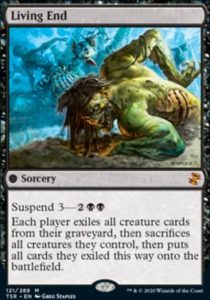
The heart of the deck. This whole guide is an exercise in making it as deadly as possible. All versions play at least three copies of it in the maindeck. Some opt to play a full playset, mostly because when it’s drawn, it can be used as a fuel for Grief. Personally, I usually opt for playing three maindeck copies, with the fourth copy in the sideboard to bring in against decks with countermagic to not run out of Living Ends too often.
You will often find me repeating that Living End is a Wrath of God effect, but technically it’s a bit different. Creatures go from the graveyard to the exile, then everyone sacrifices all their creatures, and finally the ones from exile enter the battlefield. This can be positive or negative for us, depending on what situation on board is presented. For instance, the sacrifice aspect is quite useful against creatures with Indestructible. Similarly, protection, hexproof, or other effects in this vein won’t work. On the other hand, this can be problematic for example against Yawgmoth. when the opponent has Undying creatures on board – after the Living End, they will come back with a +1/+1 counter. The sacrifice effect also matches up poorly with a big Hangarback Walker out of Hardened Scales].
Cascade spells
After the Violent Outburst ban, the only two playable options we have are Shardless Agent and Ardent Plea (technically, there’s also Demonic Dread, but the colour combination it uses and the fact that it requires a target to be cast makes it close to unplayable). In terms of upsides, they are quite similar to each other – they’re both for three mana, they’re blue, so can be pitched to Force of Negation and Subtlety, and both can be cast only at sorcery speed. The only real difference is that one is attached to a 2/2 body, and the second one grants Exalted. Agent can also make cards like Deafening Silence or Ethersworn Canonist not relevant because it’s an artifact creature, but it doesn’t matter that much.
Cyclers
The glue that holds the deck together. Having so many of them in the deck is a reason why Living End is so consistent and why it mulligans well.
Don’t tunnel vision into using them only as cyclers – sometimes all you need to win the game is a bunch of limited grade beaters, especially post sideboard when the opponents often overload on hate cards.
Curator of Mysteries
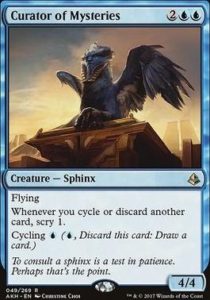
Curator is by far the best cycler to hardcast, as a 4/4 flyer for four mana with an upside attached to it is nothing to scoff at. Quite often, it’s an impactful turn four play after we went for a small Living End on turn three, just to apply more pressure. The only drawback of its cheap casting cost is that it can more easily die to some removal spells – Fatal Push or Prismatic Ending come to mind. And don’t forget about the scry! It’s an elegant way to help you find the responses you’ll need after Living End resolves.
Pro tip: scry triggers most often go to the stack when you cycle creatures, but it’s not the only way to achieve that. They work on several other occasions too! Discard spells cast by the opponent, using our Channel lands, discarding to hand size, and many other situations – they all can matter! Also note that if you resolve LE and have both Architects of Will and Curator on board, don’t forget to set up your top three keeping in mind that you can send cards to the bottom before you draw from the cycle. It’s mostly useful when you need to dig towards a specific reactive card.
Striped Riverwinder
Big Hexproof creature, useful against decks that have a lot of removal. It particularly shines against Solitude + Ephemerate decks and the more I expect to play against a lot of them, the more copies I play. Usually, the first cycler to cut so I can fit more Riverwinders is Curator of Mysteries.
Street Wraith
Our only cycler that can be used for zero mana. It often seems to be free, but in some matchups losing life is even worse than paying mana for the effect. On top of that, from time to time it’s better to not cycle it at all and use it as a fuel for Grief instead. Still, it’s almost always needed if you want to set up turn four kills. It works nicely against one-shot grave hate since it can be cycled without spending mana after the opponent uses their Relic of Progenitus / Nihil Spellbomb and before Living End resolves. Don’t forget about Swampwalk – it’s a relevant ability! It’s good in obvious situations like against Domain, Scam, and Yawgmoth. But it’s also relevant vs Primeval Titan decks, thanks to Dryad of the Ilysian Grove and its ability to make all opponent’s lands have all basic land types, so they become swamps too.
Architects of Will
It’s the weakest cycler we have access to, but it’s a necessary evil if we want to play Grief. Often used as a pitch card since it’s both blue and black. Still, if you don’t have anything else to do, you’ll cycle it from time to time. 3/3 is far from being good but having it helps to get a critical mass of creatures. The architect’s ability is kinda tricky. You can use it on yourself to dig for cards that are needed at the moment like FoN, blue cards, or a Channel land. It works nicely with fetchlands, as you can combine them to get sort of a one-shot Sensei Divining’s Top activation. A more commonly used option is to check the opponent’s top three cards to make sure they’ll never come back to the game. When combined with Grief, it gives you perfect information about what will happen in the next turn or two.
Waker of Waves
Huge creature, huge ‘cycling’ cost, and a twice as big reward for the effort. Instead of just drawing from the top, you get a small card manipulation effect, so finding exact cards for pitch spells is a bit easier. In an ideal world Waker of Waves should help you find a missing piece for your game plan like a third land, cascade spell, interaction, or a card to pitch and put another creature in the graveyard. By itself, it’s a body that can’t be ignored – 7/7 usually board stalls the ground, so our fliers can finish the job. Also, don’t underestimate its static ability! You’ll be surprised how often it impacts the game.
While the effect of the card is quite powerful, there are also some risks attached to the two mana cycler. It can be awkward with surveil lands and Generous Ent on turn two, especially when we know we’ll have to play a cascade spell next turn and we want to ensure getting the third land drop. There’s also a chance we won’t find a creature in the top two cards, so for two mana we’ll get only one creature, which is not an efficient use of our mana. It can also be awkward with reactive two mana effects like Foundation Breaker or Brazen Borrower, or on turn four when you have four lands, a cascade spell at the ready, and the opponent with a one-shot graveyard hate – a one mana cycler could have been used to fill up the graveyard after they used their interaction.
Generous Ent (and landcyclers in general)
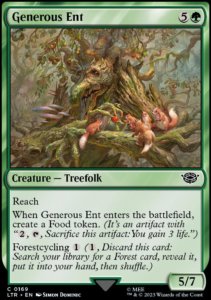
One mana landcyclers are great in Living End, because they let you play fewer lands while still being able to have three lands on curve consistently. Having more cyclers is also helpful – it means that, compared to the times before they were printed, it’s easier to find space for more interactive spells. In the ideal world, I would like to play six landcyclers. The problem is that Generous Ent is the only reasonable landcycler in Bant colours – Eagles of the North aren’t very impressive, and both Oliphaunt and Troll of Khazad-dum could technically be added to the deck, but they would make the manabase much worse. Luckily, Ent does it all – it fixes the mana and it’s a huge creature, as a 5/7 body for one mana is no joke. The abilities are also relevant: Reach allows it to block some of the most important creatures in Modern, and the Food token helps you avoid dying from an otherwise lethal burn spell.
Interactive spells
Living End is not the fastest combo deck ever created – turn four kills can happen from time to time, but it requires having a really good draw and an opponent that doesn’t interact with us. That’s why Living End needs some ways to slow down the opposition, as it can’t race some decks that care only about goldfishing as fast as possible.
Why are pitch spells so good in Living End?
Grief, Subtlety, and Force of Negation are the mainstays in Living End ever since they were printed. There are a few reasons why:
- Because of the deckbuilding restrictions Living End has, we can’t play many quality cards. Pitch spells are the strongest interactive spells we have access to.
- Living End creates card advantage in a weird way – you spend mana on cycling, so the amount of cards in hand stays the same. Then, a resolved Living End reanimates multiple creatures. So thanks to one card, you got multiple creatures on the board, ready to dominate. This card advantage engine lets us go down on cards while interacting with the opponent, because if we execute our gameplan, we’ll get back the resources later on.
- Grief and Subtlety are creatures, which matters with Living End, but I’m pretty sure they will be played to some extent even if they weren’t creatures.
Grief
In Living End, Grief is a better Unmask, which already says a lot. It also comes back after Living End resolves, so it naturally fits to the deck. It’s our only maindeckable way to beat countermagic and works well against basically anything else since every deck will have good cards you’ll be happy to discard. Sometimes it can be awkward though – for example if the only card you get target is a creature that can be problematic after Living End resolves (Primeval Titan in Amulet comes to mind).
Make sure you’ll have enough black cards to cast it. During sideboarding, don’t keep Grief and side out too many black cards!
Post side Grief can be great or disappointing. It all comes down to how the opponent wants to interact – if they are going for spell-based things like countermagic or more expensive cards like Blood Moon or Teferi, then Grief is exceptional. Versus cheaper, permanent-based stuff like Chalice of the Void and other grave hate cards that can be deployed on turn one it’s highly situational, since it might miss it completely on the draw, so if you expect to see those type of hate cards, think about whether Grief is still good enough on the draw. It’s also important to note that the black Incarnation is a decent solution to its green cousin – it forces them to cast it when it’s convenient for us rather than them.
Subtlety
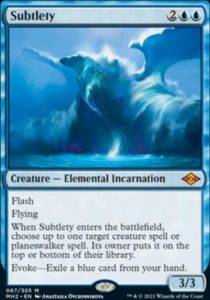
In my opinion, the very existence of Endurance is enough to make Subtlety a necessity in the 75. Nowadays, with Modern being more creature-centric than ever and without the FoN backing up Violent Outburst, Subtlety becomes even better than it was before. For me, it’s often good enough to be played as a four-of in the maindeck. It covers a lot of key cards in the current format: Grief, Ragavan, Primeval Titan, Dauthi Voidwalker, Teferi, Time Raveler, Yawgmoth, Karn, the Great Creator and many more. It’s also a good tempo play against Domain Zoo or any other creature deck that relies on putting the pressure early. In some matchups, Subtlety is an important piece of the flash game plan.
The most important thing you should note: Subtlety is not a hard answer to anything. The opponent can always decide to put the spell we target with the trigger back to the top of the deck. That’s why Subtlety should be considered as a tempo card that works nicely with Living End’s gameplan, not a solution to any problem. For instance, it’s a good answer to a turn three Teferi when we are on a draw, assuming that we have a cascade spell as a follow-up. If we don’t, it will only delay the inevitable.
Force of Negation
In the past, it was an auto four-of in the every Living End list. Nowadays, when Living End is a sorcery-speed combo, Force loses a lot of its power. It’s more of an interaction spell we use to disrupt our opponent’s plans, not to protect ours. In my opinion, it’s debatable if it’s needed in the maindeck and I can imagine metagames when I wouldn’t play it in my starting sixty. On the other hand, given the fact that cards like The One Ring, Indomitable Creativity, Teferi, Time Ralever, Karn, the Great Creator or noncreature hate exist, I would play a full playset in my seventy five one way or another. For now, I often run a 3/1 split or four in the maindeck and I side them out when necessary.
Other playable options
Faerie Macabre
The card may look a bit out of place, but in my opinion it does a lot of small things that help neutralise some of the most efficient strategies used to combat Living End. I’ll write down a few reasons why it’s so good:
- Faerie Macabre can exile the opponent’s creatures before Living End resolves. With Living End being played exclusively at sorcery speed these days, having a haymaker in graveyard means that the opponent will untap with it first, so for example Primeval Titan will be able to attack and unlock the Valakut + Dryad kill
- Faerie is an answer to Dauthi Voidwalker. Once you put Living End on the stack and Dauthi Voidwalker hits the graveyard (usually they sacrifice it in response to the LE), you’ll have a window to exile it. As a result, Voidwalker won’t come back, won’t exile Living End and won’t be able to cast it and reset the board
- It’s an uncounterable answer to Goryo’s Vengeance. Even Teferi’s static won’t stop it!
- It ‘counters’ a Surgical Extraction targeting Living End – once you exile it in response, Surgical loses all legal targets and fizzles
It also works well with the deck. It’s a 2/2 flyer that can be discarded for free and will return after Living End resolves, so it’s yet another way to create some form of board presence when facing one-shot graveyard hate. It can also be a fuel for Grief. The combination of being not terrible in vacuum and a gamechanger from time to time makes me want to play a few copies in the 75. Even maindecking it can make sense in some metagames.
Bounce spells: Brazen Borrower and Colossal Skyturtle
From time to time, it can be correct to play one or two copies of bounce spells. When choosing between these two, think about their pros and cons:
- Colossal Skyturtle can bounce only creatures, but it works well with the Living End plan, can rebuy an important spell, and it’s a green card for Force of Vigor and Endurance.
- Brazen Borrower doesn’t work with the Living End’s gameplan that well, but can bounce anything (so for example it’s a reasonable answer to Leyline of the Void) and can be hardcasted as a reasonable threat.
In practice, I rarely find a slot for them in the maindeck. I like having one Borrower in the sideboard though, as a way to deal with Leyline of the Void that can have other uses when needed.
The mana base
Living End, just like basically any other two-colour deck with a light splash for a third one, plays a mana base centred around fetchlands and shocklands. The primary colour is blue, and most of your lands should produce it, to ensure chaining cyclers in early turns consistently. Green is more important than it should be based on colour requirements, because we need enough targets for Generous Ent. White is used only for Ardent Plea and sometimes for some unusual sideboard options, and in 95% of games having one white source should cover all your needs. Usually, the core of the manabase is made of five or six fetchlands, two basic lands (Forest and Island to reduce the damage from the manabase and to play around Blood Moon), two (or sometimes three) surveil lands to increase deck’s consistency, and one of of each Breeding Pool, Hallowed Fountain, and Temple Garden. The last one may look strange, considering the deck wants to chain blue cyclers, but it’s needed as a way to get white mana from Generous Ent. Also, having the first nonblue land isn’t the end of the world since both Ent and Waker, as well as all expensive spells we would like to cast in the mid game will be able to use it. The problems start with two nonblue lands in the early game. To avoid that, I tend to play as few nonblue lands as possible.
Surveil lands
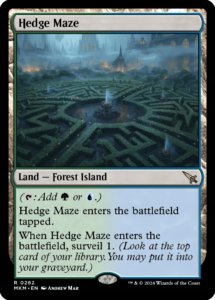
Surveil lands are the newest addition to the Living End’s manabase. At first, it may look counterintuitive to add them to the deck that wants to always use the mana early to cycle creatures and cast cascade spells, but it turned out that they fit to the strategy quite well. Increasing consistency in finding a missing land drop or a cascade spell is just the beginning. Living End uses the surveil ability very efficiently. Since more than half of the deck are creatures, you’ll have over 50% of chances to flip a creature with it. So in a way, you play a tapland that has over 50% of chances to enter the battlefield ‘untapped’ and cycle a creature from the top. The fact that this effect is attached to the fetchable land makes your hands without multiple cyclers better, because any fetchland or Generous Ent has decent chances of putting yet another creature in the graveyard. For example, hands with three lands including a fetchland, Waker of Waves, and Shardless Agent are much better with Surveil lands in the mix.
While surveil lands are quite good at increasing consistency, they also can lead to some troubles in goldfishing scenarios, especially if you plan to spend mana on something that costs two or more. For example, if you play it on turn two, it won’t let you use Waker. Or if you find it with Waker of Waves on turn two, it won’t enable a turn three cascade. Similarly, playing it on turn four won’t open you an option to hardcast a turn four Subtlety and so on.
In my opinion, the risk to reward calculation favours playing Surveil lands. I’m advocating for running two Hedge Mazes. Two because I want to have access to the effect more than once, but not more because of tempo reasons. And I like this colour combination the most because they both produce blue (the most important colour) and can be tutored by Generous Ents. In the past, I tried Lush Portico, but with Forest, Temple Garden, and Boseiju already in the deck, I didn’t want to have that yet another nonblue land.
The rest of the manabase
The last few slots for lands can be filled with options that do something more than just producing mana. I wrote down the best ones below:
- Otawara, Soaring City – four mana bounce doesn’t look like a great effect at first glance, but Otawara’s true power lies in being a great response to Teferi, Time Raveler. Uncounterable, undiscardable, and most importantly, can be used in their end step, even through Teferi’s static. There are also other uses like bouncing basically all hate cards, Urza’s Saga to not let the opponent search for the hate card, or anything that’s on the battlefield. You can also return your own Shardless to hand for another go. To be honest, the effect isn’t the best because it costs four mana (which is a lot), but Otawara being land is a key here – finding playable cards that don’t mess with the deckbuilding restrictions that cascade mechanic imposes on us is hard. Also producing blue mana is extremely important, as every cycler in the deck can be cycled off of it – I probably wouldn’t play it if it was producing another colour instead. Playing the first copy is a free roll, and I encourage you to do so.
- Boseiju, Who Endures – At first, it looks like a perfect answer for the deck, as it covers almost all commonly played sideboard hate cards. The fact that it’s never dead since it works as a land if there aren’t relevant targets is really enticing, but compared to Otawara, it has one huge downside – it doesn’t produce blue mana. In my opinion, you have to think about it more like a spell with the option of being a land than the opposite. Boseiju can also randomly attack manabases (for instance vs Amulet, Tron, or Belcher), so it has its upsides too. If you expect to see a lot of good targets for it in game one, it’s relatively safe to add one copy to the deck and play it as an extra land.
- Fastlands – they’re played in order to minimise the damage taken from the manabase. Similarly to Otawara, playing the first one is more or less free. I like the UW colour pair here because of how good it works with Generous Ent – when combined, it often allows you to have the perfect mana.
- Black lands: Urborg, Tomb of Yawgmoth and Sunken Ruins – the idea is to get double black to hardcast Grief and Street Wraith from one land. It comes at the cost of having a worse manabase to execute our regular game plan, so most of the time it won’t be worth it. I can see it being a reasonable option in slower metagames with a lot of spell-based hate, when hardcasting Grief is often a solid play.
Sideboard options
Because of both the cascade restrictions and the need to spend our mana early on to cycle, we often won’t have the luxury of casting our reactive spells early in the game. Because of that, the best sideboard options for the deck are cards that can be utilised for as little mana as possible (ideally zero), while still costing three or more for the cascade purposes. We can separate them into few categories:
- Creatures with Evoke mechanic (Foundation Breaker
- Forces cycle from Modern Horizons 1 (Force of Vigor)
- Elemental cycle from Modern Horizons 2 (Endurance, Subtlety)
- Leylines (Leyline of Sanctity, Leyline of the Void)
- Split cards (Consign//Oblivion)
- Cards with a special text/abilitiy that lets us cast/use them cheaper in certain circumstances (Mystical Dispute, Faerie Macabre)
- Cards with Phyrexian mana as a cost (Dismember)
- Channel lands (Boseiju, Who Endures)
- Cards that are meant to be cast in a regular way, for three or more mana ( Temporary Lockdown, Damping Matrix )
Based on this list alone, you could think that there are a lot of interesting options for the deck, but the reality is much more grim – many of these cards are cards that we can play, but we aren’t happy to do so. For instance, Foundation Breaker isn’t the best disenchant effect in the game, but we can’t playing anything better than it. Below you’ll find all playable or even semi-playable options for Living End.
Note that some of the cards mentioned above (Subtlety, Force of Negation, Living End, Faerie Macabre, and Brazen Borrower) often act as sideboard options. I won’t mention them here once again, but I hope you’ll connect the dots.
Mystical Dispute
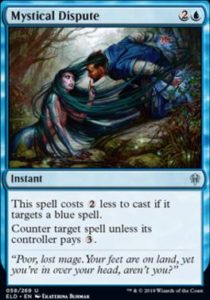
Cheap way to protect our key spell from countermagic. Unsurprisingly, it’s mainly used against blue decks – if you expect to fight on the stack, siding it in is never a bad idea. It’s also a solid answer to Teferi, Time Raveler and some hate bears, like Meddling Mage or Lavinia, Azorius Renegade. It can also be brought in as the ‘bad Mana Leak‘ when all you need in the matchup is to set up a pressure and counter anything they’ll play later on.
Note that Mystical Dispute loses its power as the game goes longer – every land drop on the other side of the table decreases its impact on the game, and this issue if even more exacerbated withRagavan, Nimble Pilferer creating a Treasure each turn. We also need to delay our combo for one turn if we want to have it up for the potential counter war. The window for Mystical Dispute to show its power is not as wide as many players would think, which is why drawing too many of them can be problematic. On the other hand, we don’t have anything better than it, so we are forced to use it until a superior option is printed.
Foundation Breaker
It’s hard to argue against Breaker clunkiness – a two mana, sorcery speed Naturalize is far from being a Modern powerhouse. It’s played mostly because of how well it works with Living End – if uncontested, Breaker will be able to deal with two targets: the first one before and the second one after we bring our creatures back. Its main purpose is to deal with Urza’s Saga, but it also has some other important uses. For example, it’s a good, clean answer to Leyline of the Void, Chalice of the Void, and Blood Moon (assuming you’ve fetched Forest earlier). Sometimes, siding in one or two copies when a midrange player has access to two Relic of Progenitus or Unlicensed Hearses is a perfectly fine play. Sure, you might end up with a dead card in hand, but there will be games when having Breaker will be a critical.
Pro tip #1: Remember about stacking triggers correctly. You usually want the Naturalize effect to resolve first, so your Foundation Breaker ends up in the graveyard rather than on exile against things like Leyline of the Void or Rest in Peace.
Pro tip #2: Foundation Breaker has a ‘may’ ability, so you won’t be forced to destroy anything if there are no beneficial targets.
Force of Vigor
In terms of raw power, Force of Vigor is in another league than Foundation Breaker. It’s an instant free spell that trades even on cards. In theory, it’s easy to assume that we should play as many copies of it as possible. In practice, it’s not that easy to cast without Violent Outburst, because of the lack of green cards in the deck. It’s not impossible to do so, but in my opinion you should have a good reason to play it over Foundation Breaker. For example, if the metagame will be focused heavily around Urza’s Saga decks, then going harder on FoVs can be relevant and I run as many as three or even four copies, so you could bring in a lot of green cards to make pitching it more consistent. But if your goal is to focus on a single target, for example Urza’s Saga in Amulet, or any single piece of hate that opponent could have (Leyline of the Void, Chalice, one-shot grave hate cards, Unlicensed Hearse, Soulless Jalier, etc.), you should play Foundation Breaker instead.
Endurance
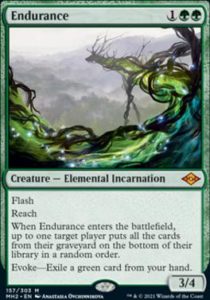
It’s a hybrid of a flash threat with solid stats and a graveyard hate. The biggest strength of the card is that both hardcast and pitching a green card to play it for zero mana are valuable and useful. Casting it for zero mana shines against linear strategies – in the mirror, against Goryo’s Vengeance, Underworld Breach decks or other fringe options like Dredge or Storm. The lack of green cards in this build makes it challenging to do so consistently though.
The more fair the matchup is, the better hardcasting Endurance becomes. And you shouldn’t consider it a bad play – thanks to good stats compared to casting cost, how its power and toughness match up with some of the creatures in the format (I’m looking at you Dragon’s Rage Channeler), and how impactful its ability can be in fair fights, Endurance can be effective as a threat against blue tempo decks. It either grants some value or forces the opponent to tap out, so we’ll be able to go for the our combo. This strategy became even more impactful after the Violent’s Outburst ban, mostly because without it, we now lack any other better ways to spend mana and potentially force the opponent to tap out on their turn. Similarly, Endurance is a solid way to neutralise the opponent’s graveyard filled with creatures that got there ahead of schedule somehow.
Sometimes, it’s okay to target yourself with the trigger. It happens mostly against Mill, and sometimes in the mirror or against control decks, when Endurance returns from the graveyard thanks to Living End and you can shuffle your Living End(s) back to the deck.
Leyline of the Void
An ultimate weapon against graveyard strategies. You need to have it in the opening to make it work, but unlike Leyline of Sanctity, it can at least be pitched to Grief if drawn later on. Use it if you expect to play against a lot of decks that heavily rely on the graveyard – for example the mirror, Underworld Breach decks, etc. It can also be sideboarded against some DRC decks, but I’m not the biggest fan of it, since you can still lose to their countermagic and, unlike Endurance, Leyline won’t threat the opponent to win the game by any means.
There’s also one aspect of the card that’s often missed by players – the fear factor. When we cascade, we show the opponent a lot of cards. There’s a decent chance that even if we didn’t have Leyline in the opening hand, the opponent would see it while we are looking for Living End. This information can affect the opponent’s sideboarding strategy for game three. They will often end up with a deck with three, maybe four responses to it. So if we start game three without the Leyline again (which is more likely than having it), they will automatically have a few dead cards in the deck. And even if we do have it and they’ll have a response, we would still end up with a tempo advantage anyway. That’s why I strongly believe that having at least one copy of Leyline of the Void can give you an edge in game threes and it can give you a better chance to win than what are the odds of finding it in the opening hand.
Leyline of Sanctity
In the past, Leyline of Sanctity was played to stop Endurance, discard spells, Burn, and fringe combo decks like Belcher or Calibrated Blast. Due to cards like Boseiju, Leyline Binding, Teferi, Haywire Mite, etc. it lost some of its power and it’s not as heavily played as it was before – it’s just too easy to answer, and there are better tools to stop all of the cards that were mentioned above. But it’s good to keep in mind the card exists and use it when the metagame isn’t ready for it.
Dismember
Probably the only reasonable creature removal we have access to that can kill nearly all creatures that can enter the battlefield in the early turns of the game. Dismember has its disadvantages though: losing four life is a real cost and because of it, it shouldn’t be considered as a way to survive an early game against tempo decks. But it’s at least a solid tool to combat hate bears: Magus of the Moon, Meddling Mage, Lavinia, Archon of Emeria, etc. If the metagame shifts towards these, make sure to pack some Dismembers.
Ashiok, Dream Render
A narrow card that’s very effective against one strategy – Amulet. It attacks basically every important card in their deck: it affects Urza’s Saga tutoring for Amulet, makes Summoner’s Pact and Tolaria West blanks, Primeval Titan becomes a 6/6 Trampler with no additional text, etc. At the same time it solves the big problem Living End had in the matchup – Amulet players discarding Primeval Titan or Cultivator Colossus to hand size. Just mill yourself and exile your opponent’s graveyard.
Ashiok isn’t that useful against any other strategy. I can see it being okay against Scapeshift decks and maybe acceptable in the mirror.
Commandeer
Technically, it’s a solid answer to The One Ring. But outside of that, I don’t see a reason to play it. Exiling two cards is a real cost and with other pitch spells we have, it will be quite hard to get there.
Inevitable Betrayal
I saw players using it as a pivot strategy against decks like Tron or Goryo’s Vengeance. I’m not the biggest fan of it because to make it work, you’re making your deck not functional outside of resolving Betrayal. And you won’t be 100% sure that this one creature will be able to get there. For example, a turn three Ulamog would still lose to their turn three Karn Liberated or Karn, the Great Creator into Ensnaring Bridge. Or Atraxa can still be exiled by Solitude.
Solitude (and white colour as a whole)
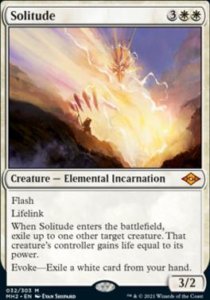
Living End was never a white deck, so after the Violent Outburst ban, once I convinced myself that Ardent Plea is the way to go, I spent some time on Scryfall, scouring for the best options in white. I wasn’t pleased with my findings – cyclers were either small or overcosted, and there’s only one good white pitch spell – Solitude. While the card is phenomenal in some strategies, I was never the biggest fan of it in Living End – if we plan to wrath the opponent’s board, what’s the point of playing point removal in the first place? This reminds me of Fury, but the red Incarnation at least attacked for a lot of damage, especially when combined with Oliphaunt. Solitude is only a 3/2 without evasion, luckily with Lifelink which is sometimes relevant, so I decided to give it a try. To make it castable, I had to add white cards. Since black cards were untouchable because of Grief, I had to trim a few blue cyclers and Generous Ents to make room for Eagles of the North and Glassdusk Hulk. The results weren’t great – Solitude shined against Dauthi Voidwalker, but in goldfish situations, it wasn’t very impressive. Also the size of cyclers mattered a lot – 3/3 Eagles and 3/4 Hulks just couldn’t compete with 5/7 Ents and 4/4 Curators. They were much worse at closing out the game and the more untaps the opponent had, the worse things could go. That was the moment when I realised how important it is to have cyclers that are huge creatures. Generous Ent, Waker of Waves, and Curator of Mysteries/Striped Riverwinder are the future of the archetype.
Teferi, Time Raveler
Teferi looks like the next best white card Living End can use because of the restrictions. In theory, I like it – it’s the best answer to Flusterstorm, Invasive Surgery, Test of Talents, etc., and can act as a temporary solution to permanent-based hate like Leyline of the Void or Chalice of the Void. But in practice, I rarely wanted to cast it over Cascading. Casting it against blue decks isn’t a solution – it can be countered easily with Spell Pierce and even if it resolves, it can be killed in combat. Or if we tapout for our Teferi and the opponent will resolve theirs, we’ll be behind at the end of the day because on average our plan B is worse than the opponent’s. I can see the card being good in some scenarios and metagames, but, similarly to what happened in Rhinos, it’s far from being an auto-include. I can see it being playable in some weird metagames, but it’s not a Living End’s staple for sure.
Temporary Lockdown
If you need a mass removal spell that’s not Living End, Lockdown is the best option we have at the moment. It has a few upsides compared to other options. Firstly, it doesn’t put removed permanents to the graveyard, so it won’t affect Living End. It exiles not only creatures, but every nonland permanent, including multiple noncreature hate pieces the opponent can have, and any form of Indestructible, Hexproof, or Regeneration won’t protect them. The card also has some significant problems though. It costs double white, so the manabase isn’t suited for consistently casting it on curve. And if you decide to do it anyway, you’ll most likely lose five or six life in the process, which isn’t ideal against any aggressive strategy. It also interacts horribly with Leyline Binding or removal in general – if the opponent plays it in the response to the Lockdown’s trigger, nothing will get exiled.
I can see Temporary Lockdown being played in the meta with a lot of small creatures that play a lot of artifact hate, for example Hardened Scales. Just make sure you’ll rebuild the manabase a bit to fully support casting it.
Damping Matrix
When there is a lot of artifact-based hate that requires activation (like Relic of Progenitus, Tormod’s Crypt, etc.), you can consider playing Damping Matrix as a one-off. The good thing is that no one will side in dedicated answers to the Matrix, so once it resolves, you’ll be able to block all their hate cards at once without the fear of them removing your own lock piece. There’s also a possibility to stop a creature combo decks such as Yawgmoth or Heliod. I’m not the biggest fan of this plan though because it usually won’t be enough to win a matchup – it’s better to focus on how to neutralize their hate of choice.
Gameplay
At the first glance, Living End looks like a very straightforward combo deck – cycle a few creatures, play a cascade spell, and win shortly after. And to be honest with you, a lot of games will come down to whether you can execute this gameplan early or not. But thanks to the fact that Living End is a one-card combo, it means that it can have more interaction than any other combo deck in the format. Living End has the tools to act as a combo, control, or tempo deck. Depending on the played matchup, we can adapt with the timing on cyclers, casting cascade, and interactive spells and dictate the pace of the game. If you want to play the deck like a pro, you need to know how to maximise the odds of executing your own gameplan (it usually comes down to maximising the odds of drawing what you need in early turns of the game) and when you should use one gameplan over another.
How you should use cyclers
The most challenging aspect of the deck is the correct order to cycle our dudes. It’s close to impossible to give you one, golden rule about how to do it. Instead, I wrote down a few pieces of advice. The most important lesson for you from this section is that you should always ask yourself before any action (by this I mean cycling, making a land drop, cracking a fetchland, cascading, etc.) what you want to achieve. What are your goals? What outcome do you want to maximise? This should dictate what line you should take in a given situation. I strongly recommend not rushing actions, but think first before you take any. Living End does not need a lot of time to finish its matches. Like Paulo Victor Damo Da Rosa once said: ‘think, think, think then do, do, do’.
The timing of the cycling actions
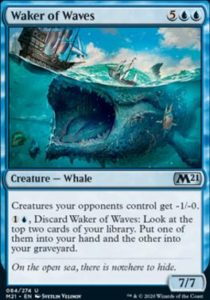
The default mode is to use cycle abilities on the opponent’s end step. The reasoning behind this is not giving free information to the opponent. If you cycle during your turn, you clearly show the opponent that you are in trouble (for instance you don’t have land drops) and you were forced to let your guard down and increase the potential damage the opponent’s hate could do. The longer you expose your cyclers, the more vulnerable they are to grave hate actions – this can matter a lot in post-sideboard games against sorcery speed grave hate, like Bojuka Bog, or any one-shot grave hate like Relic of Progenitus if we have an option to deal with it on our turn, for example with the help of Foundation Breaker – the more you cycle before opponent’s end step, the more stuff will be exiled to the hate’s activation. Cycling on the opponent’s end step is also useful vs. discard spells. Discarding a creature we meant to put into the graveyard anyway isn’t the worst, but choosing a cascade spell we drew from the top instead can be a game-winning play.
Of course, there are some exceptions to this rule.
- When you have mana problems (more on that later).
- When you really want to Evoke Grief and you lack a black card, or the Grief itself.
- When you are searching for a response to something that’s on the board. For instance Foundation Breaker vs. opponent’s Urza’s Saga on two counters.
But generally speaking, cycling at the end step is the default play. You’ll learn how to recognize corner cases in practice.
Goldfish scenario
Let’s start from the easiest examples. What should you do if you are in the goldfish mode? By this, I mean that the opponent does not interact with you, and all resources needed to turn three Cascade are already secured.
Think about the order of the creatures you are cycling. The general rule in goldfish: the bigger creatures are being cycled, the better. Waker of Waves gives you the highest upside here. It’s guaranteed seven power with a decent chance to put even more with a self mill action attached to it. Outside that, Generous Ent and Striped Riverwinder are also welcome.
Sometimes instead of just the highest power on board, you’ll need evasion the most. In the current build, Curator of Mysteries is the only creature with flying. Also, Grief and Street Wraith have relevant abilities in terms of avoiding blockers, so you should value them more highly in these scenarios.
Street Wraith is a unique cycler, because you can use it for zero mana. This means that you can either cycle it as soon as possible, or wait for more information. My rule of thumb is that if I have my land drops secured and I have cyclers (or a surveil land) ready to use, I don’t use it. Who knows, maybe the game will turn into a tight damage race and spending two life on yet another 3/4 won’t be worth it? Or maybe in the next turn I’ll draw Grief and Street Wraith will be used as fuel for it? Or the opponent will play a one-shot graveyard hate card and a Street Wraith kept in hand will turn into a creature that will be put into the graveyard out of nowhere before Living End resolves? You’ll almost always have the time to cycle it, so don’t rush it.
If you can, try to use black cyclers as the last ones. It’s because there’s always a chance to topdeck Grief and casting it for zero mana means two discard actions and an extra three power on board. If you are going for the tempo approach with turn three cascade, exiling a drawn Living End is ideal. The second best card to do it is Architects of Will because the alternative of using it (cycle for blue mana) is not for free. Pitching it to Grief means that we can use this mana for using other, better cyclers.
Cycling when playing around the hate
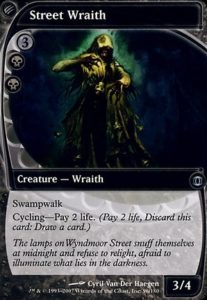
Sadly, we can’t always goldfish our way to victory. Opponents often have something prepared to stop us. But you can sequence your cyclers and do tricks to minimise the effect of their actions.
When you face one-shot grave hate like Endurance, Nihil Spellbomb, etc., remember that you’ll have a window to cycle creatures after the hate did its job and before Living End resolves. In that case, keep the best cyclers in hand and use weaker ones. After all, not cycling at all is not the best play, because you need to present a graveyard big enough to force the action on the opponent. Against one-shot grave hates cards, the most valuable cycler is Street Wraith – it’s the only one that’s not limited by the open mana you have after you cast the cascade spell. So avoid using them at any cost.
Force of Negation can be a reason to not cycle at all. If you have FoN and only one blue cycler, maybe it would be better to not do any actions and keep your counter open all the time.
There’s a chance the opponent will present something that will stop your cascade actions and you will be forced to hardcast your dudes. If you fear this outcome, try to keep Curator of Mysteries in hand, because it’s the cheapest creature in the deck we can hardcast.
Cyclers and how they interact with the manabase
Earlier, I was writing about goldfish scenarios when we don’t have any problems with the mana. But in reality, sometimes we can stumble on making land drops or can have mana screw. All you can do with cyclers is to get a couple of percentage points here and there to maximise the odds of drawing what you need from the top. Again, all can be narrowed down to one question: what do I want to achieve?
Fetchlands: If you are searching for lands from the top, crack your fetchlands at the last possible moment. Not fetching means also more lands in the deck waiting to be topdecked. Appropriately, if you want to increase your chances for a cycle chain, crack fetchlands before the cycle to lower the number of dead topdecks. If you have only one fetch and land that produces only blue mana (basic Island, or Otawara, Soaring City), it’s better to cycle before cracking – there’s a chance you’ll draw a land that produces either one or two colours, so you’ll know what third colour you’ll be missing. If you don’t have the luxury of getting extra information before using the fetchland (for instance, you’ve kept a one lander and have to grab something in the very first turn of the game), go for the Hallowed Fountain. You’ll have more green sources to topdeck, thanks to Generous Ent, Hedge Mazes, basic Forest, and Boseiju.
Low cycler count in the opening – is it a problem?
In the past, keeping a hand with one cycler was risky because there was a chance that you won’t be able to chain your cyclers and Living End won’t be that impressive. This has changed though. Nowadays, it’s okay to keep one cycler hands because each fetchland, Generous Ent, or naturally drawn surveil land can transfer our land drop into over 50% of chances of milling a creature.
Don’t be too greedy with cyclers
It’s easy to fall into the trap of ultimate cycling into creating one, huge board. But in many matchups, you won’t need thirty or more power to win. Turn one cycle, turn two more cycles into Wrath of God + ten or more power should be enough against majority of decks, especially when the interaction was involved. The more you wait with your cascade actions, the more things can go wrong. Countermagic, discard, hate cards, the combo kills out of nowhere, etc. Usually, the correct play is to not be greedy. There are exceptions though. The one that happens the most often is when you expect Solitude from the opponent or they have a few creatures in the graveyard to even the value from Living End. If that happens, it’s better to wait and cycle a bit more, so that an evoked Solitude in response to the cascade and exile + blocks and lifegain won’t neutralise our whole aggression.
Casting Grief
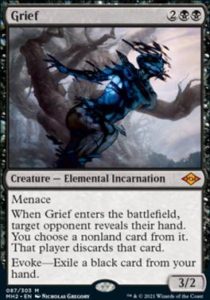
When should you cast Grief? It’s a tricky question that’s never that easy to answer. Players that are new to the strategy tend to evoke it as soon as possible and don’t think about the consequences or alternatives. While rushing it can be a good move in some matchups, I would like to show you that sometimes waiting can be rewarding. Instead of giving you golden rules, here are the guidelines for you. Answer these questions to make sure that your decision is right:
Do I have a card to pitch?
If not, you can’t cast Grief. If yes, go next.
Do I want to show that I’m playing Living End?
If you go turn one fetchland, go, the opponent won’t know what you are playing. If you add turn one Grief to that start, the info will be sold. Tiny edge, but it can give you a few win percentage points.
What do I want to hit?
Depending on the matchup, sometimes it’s a counterspell that will interact with our Living End at the last possible moment when we pull the trigger on the cascade action. But against proactive decks, maybe breaking synergies earlier in the game will be more important? Think about what you want to achieve and act accordingly to the plan.
Do I need to cast it now? Maybe casting it later will be better?
After hours of Living End coaching I came to the conclusion that players tend to use Grief as soon as they can, even when they have to exile a good black card from hand, mostly because they want to gather the information about the opponent’s hand. Firstly, the more cards you draw, the bigger are chances to find a Living End or another Grief from the top. Exiling Street Wraith or Architects of Will just to get the information faster isn’t worth it. It’s better to use a card that would be useless otherwise. There’s also an argument about maximising the value of the information you get. For instance, the opponent played turn one Steam Vents into Dragon’s Rage Channeler. You can assume it’s UR Murktide or at least something that has countermagic. Your only worry in the matchup (at least in game one) is the fight on the stack. If you go turn one Grief, there’s a chance they won’t have any countermagic at all, and the only one they’ll see in the game will be the one drawn in the next draw step. Or they’ll even have it, but they will also have enough cantrips to find another one. It’s better to wait and let them cantrip without the knowledge that one of the counters will be discarded. This lack of information can lead to them not grabbing more counters, but maybe another cheap threat, or potentially game-winning Lightning Bolt instead. The ideal situation against counters is to cast Grief on the same turn you go off.
Obviously sometimes casting Grief as fast as possible will be the play, so waiting until the turn we want to go for the cascade can lose you an otherwise won game. It requires practice and learning the given matchup. All I want to point out here is that waiting with Grief can have upsides and you should always consider every line of play you have.
Cards that come to decks post side can change the rules!
Don’t tunnel vision yourself into play patterns like ‘ against Murktide I should wait and vs. Tron, I play Grief as soon as possible’. The Grief play pattern can be different pre and post sideboard. For instance: vs. UR Murktide in game one, you want to wait with your discard, so you’ll decide if you want to cast Cascade based on full information. But post sideboard there are cards that can change things like: Blood Moon, Unlicensed Hearse, Chalice, etc. Because of the hate cards, you can be forced to Grief sooner than you would like to. Also being on the play or draw matters. The brightest example is when you are playing vs. Chalice of the Void deck: if you are on the play, there’s a chance to discard it before they’ll get a chance to cast it. On the draw, that’s not possible, so you can as well ignore this threat in choosing when to cast Grief because they would slam the Chalice if they had it.
Other random tricks and pro tips
Don’t forget about the Wrath of God side of Living End
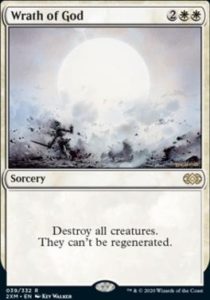
Returning your cycled creatures is an easy thing to find out. But players tend to underestimate how powerful the Wrath of God effect for three mana is, especially when it’s at instant speed. I’ve had games when I had zero cyclers in the graveyard and was still going for turn three cascade, just to buy myself more time. When you wipe out the opponent’s board, you’ll gain time to draw into more cyclers and prepare the next, game-winning Living End cast. This strategy is useful against some hate bears like Scavenging Ooze. It can also be a response to the Hammer board states that are very close to being lethal.
Learn to hold priority!
If you go for cascade effect and you want to cycle creatures just to get more power to the graveyard, and you don’t have black cards to use for a possible topdecked Grief, don’t use them before you Cascade. It’s better to cast a cascade spell first, find Living End, and announce that you want to hold priority (use ctrl on MTGO). With Living End on the stack, you’ll be able to cycle your creatures at this moment. With Living End already found and being on the stack, the chances to draw into the Living Ends are lower. It’s important when you need to resolve more than one End during the game or you have drawn one or two of them before the Cascade happened.
The differences between active and nonactive player
When you cast a Living End and multiple creatures on both sides have ETB triggers, the order of triggers going to the stack depends on who is the active player. For example, if you returned Architects of Will and Grief, and the opponent had Archon of Cruelty, all triggers go to the stack. But since you are an active player, you’ll set the order of your triggers first (in this scenario I would put Architect’s first, then Grief). After that, the opponent will put theirs. So the opponent will draw a card from Archon’s trigger first, then you’ll discard a card from their hand, then you’ll manipulate the top of the opponent’s library.
In essence – since Living End is a sorcery-speed combo now, 99% of the time the opponent’s triggers will resolve first, then you’ll resolve yours.
Brazen Borrower vs one-shot grave hate that’s on the battlefield.
Brazen Borrower can neutralise in a tricky way the opponent’s Relic of Progenitus/Nihil Spellbomb/Remorseful Cleric etc. and will even give you more value by doing that. Just try to bounce the hate card to the hand. If they let you bounce the target, your cyclers will remain in the graveyard and you can do cascade magic. If they decide to crack it in response, you’ll lose your cyclers, but at least Brazen Borrower (cast as Pretty Theft) will fizzle and will go back to the grave after the activated ability of the grave hate card resolves. So as a result, you’ll get a 3/1 for ‘free’ when the Cascade happens.
You can refuse to cast the spell you’ve cascaded into.
Sometimes all you need to win is cast a 2/2 guy for three mana. You don’t have to cast a Living End that was found thanks to the cascade trigger.
The hate
By hate, I mean everything that can stop us from executing our gameplan. We can separate hate cards into two groups:
- Soft – cards that we can overpower by just doing ‘our thing’
- Hard – cards that make our deck nonfunctional and they have to be answered with dedicated reactive cards.
Below, I listed the most common ways for your opponents to interact with Living End and what you can do to play around them – both from a card vs card perspective and from tips and tricks on how to make their effects as clunky as possible. Note that you can also beat every form of hate by hardcasting your cyclers, but this strategy is so unlikely to work that you shouldn’t consider it as a real plan, but more as a fancy way to close out weird games.
Discard
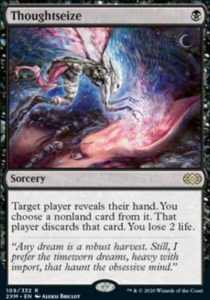
- Just topdeck another cascade spell
- Use surveil lands to increase the odds of drawing into whatever you need
- If the opponent plays a discard spell and you have cyclers in hand, just let it resolve. They will bin one of your creatures and you’ll cycle the rest of them, hoping to find a Cascade spell. If you have one cycler as your single nonland card, and not that impressive of a graveyard, I would consider cycling it anyway because there’s a chance you’ll draw a land (so it will stay in your hand) or yet another cycler, so your board presence after you topdeck a a cascade spell will be better.
Countermagic
- Discard their countermagic with Grief. While it needs to be played preemptively, and even though it doesn’t bottleneck them on mana, it solves the problem of some specific countermagic that can’t be beaten with Force, most notably Flusterstorm and Dovin’s Veto, and it provides you with a valuable information about the contents of their hand.
- Play multiple Cascade spells turn after turn and hope they run out of counters
- Mystical Dispute. While it usually trades up on mana, it also loses its power as the game goes longer. Still, it’s the best of what we have left as reasonable options for us.
- Force them to spend their mana on their turn, so you can untap and Cascade. Endurance or Subtlety can be a fine way to force the issue.
- If you want to play around some soft counters like Spell Pierce or even Flusterstorm, play a longer game and make land drops. After you get into five or more lands in play, it’s often a good idea to play around their soft countermagic rather than to cycle the sixth or seventh monster to overkill them with Living End.
Cranial Extraction effects
- Effects like Necromentia or Unmoored Ego are quite hard to beat for a deck that’s named after a card. Outside our regular reactive cards – Grief and Force of Negation – only Leyline of Sanctity can protect us from losing on the spot
- If the hate card is exactly Surgical Extraction, you can exile the target in the response (for example by using Faerie Macabre on targeted Living End) and it will effectively counter it
Permanent-based non-graveyard hate
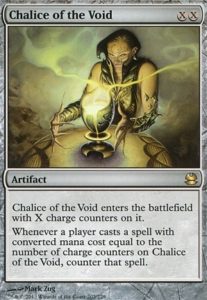
- Soft tax effects like Thalia, Guardian of Thraben or Damping Sphere can be outplayed by making your land drops.
- Hard hate effects like Teferi, Time Raveler, Chalice of the Void, Lavinia, Azorius Renegade, Meddling Mage, Soulless Jalier, Ensnaring Bridge, etc. require a real answer. Luckily for us, against all of the mentioned cards, you’ll find three or more reasonable answers. Grief can take all of them, but it has to be played early and they can’t topdeck the hate card later on. Force of Negation counters noncreature spells, Subtlety delays creatures and planeswalkers, and Dismember solves the hate bear problem. You can also use Channel lands, Mystical Dispute, and Foundation Breaker/Force of Vigor. So there are plenty of ways to deal with hate cards. Just make sure you choose the most efficient ones.
Graveyard hate
Graveyard hate is probably the group of cards that are most often sided in vs. Living End. Many players play it because it tends to be good against many other strategies that rely on their graveyard to varying degrees. It can have a devastating impact on Living End’s game plan and it’s relatively hard to play around, but there are some tricks you can do to play around these effects or at least gain a little advantage with good timing or sequencing. Oh, and you can Force them or Grief them as well.
One-shot graveyard hate
These effects are the most common ones in the graveyard hate world. They have a lot in common – players usually wait with using them until we cast a cascade spell, they need to be used to have an effect and after it resolves, the Living End is still on the stack. Once we get a priority, there’s a chance to cycle creatures and get at least some value out of the Cascading – that’s the most common way to beat this type of interaction. Another way to deal with them is to force activation of the hate card when we want it – in early turns before we spend mana and cards to fill the graveyard with cycled creatures. For Endurance the ‘trigger card’ is Grief, and for artifact-based hate we have Foundation Breaker, Force of Vigor and bounce effects. Grave hate cards that target (Endurance, Tormod’s Crypt, Nihil Spellbomb) can be stopped with Leyline of Sanctity. Endurance can also be answered with the help of Subtlety. We can also just counter or discard them before they become a problem.
Relic of Progenitus note: the card is quite unique in the world of one-shot grave hate options, as it has a tap ability that can decrease the amount of potential power over time. There are two ways to play around it. The first is to use cards that can put additional cards to the graveyard – fetchlands and Waker of Waves are good examples of that. The second one is to wait with your cyclers until you can cycle two or more per turn, so at least some of them will threaten the opponent and force the activation of Relic. Similarly, you can overpower Unlicensed Hearse.
Other soft grave hate cards
Scavenging Ooze
Subtlety is an efficient way to delay it to the point when casting it isn’t that much of a threat, because we should have a graveyard filled with cyclers and losing one or two of them shouldn’t be a problem. And since it’s a creature, it will just die to Living End. Even if you don’t have cyclers in the graveyard, it’s a good way to deal with it – the more you wait, the more resources Ooze will eat, so if it’s on the board, just go for turn three cascade if possible. Once it’s off the battlefield, just cycle again and cast the next, game-winning Living End later.
Bojuka Bog
It’s a sorcery speed one-shot grave hate that’s played in Amulet. Because of the Ravnica bounce lands, it’s possible for the opponent to play it more than once, so it can be quite annoying to play against. But on the other hand, it’s somewhat easy to play around – end step cycling into cascade works nicely. Leyline of Sanctity also stops it.
Ashiok, Dream Render
We don’t really care about it for the most part – just remember to use fetchlands early and cycle in their end step. After they cast Ashiok, try to cycle two or three creatures, untap, and go for the cascade. It should be relatively easy to overpower it.
Hard grave hate
Dauthi Voidwalker
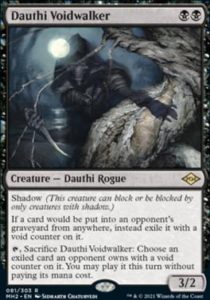
Dauthi Voidwalker attacks Living End from two different angles. When it’s on the battlefield, it’s a Leyline of the Void for your cyclers. And when it’s in the graveyard, it’s a way to ‘counter’ a resolved Living End. During resolution, Voidwalker returns to the battlefield, so it will be in play when Living End finally resolves. That means that it will be exiled by Vodwalker’s static ability and after the opponent untaps, they will be able to cast it, Living End then goes on the stack, the board gets cleared, and Voidwalker once again comes back into play. It’s extremely annoying to play against, but there are a few ways to not let it happen:
- If we start the game, it’s possible to cycle on turn one and two before Voidwalker resolves. At this point, we won’t be able to effectively cycle more stuff, but cascading into Living End will kill their creature and return our dudes to the battlefield. What’s very important in this scenario is that Dauthi Voidwalker has summoning sickness, so it can’t sacrifice itself to start the loop.
- You can not let Voidwalker enter the battlefield by using Subtlety.
- Faerie Macabre and Endurance can remove Voidwalker from the graveyard, so it won’t return after Living End resolves.
- You can kill Voidwalker after it returns from Living End, but before it loses summoning sickness. It was somewhat common with Fury in the format, and now it’s hard to accomplish. Harvester of Misery or Dismember could maybe do it.
- Force of Negation can counter the Living End that was cast via Voidwalker’s ability.
Rest in Peace
- Grief or FoN it or you’re in big trouble.
- After it resolves, you can still answer it either by destroying or bouncing it, but you won’t be able to get back things it exiled before you dealt with it.
- Don’t forget that Rest in Peace works for both players, so in a strange way, it can help you. For instance, if RiP was played by a creature deck, it’s relatively easy to control the board with eight Wrath of God effects. And thanks to graveyards being perpetually empty, all creatures killed this way will be gone forever and you won’t need to worry about them returning later in the game. In the extreme late game, casting seven drops can be a reasonable strategy. I’ve had games where the opponent went for RiP into the board, I went for two sweepers and won later on with hardcasted cyclers. Just make sure you hit land drops, and don’t cycle unless you need to dig for lands.
Leyline of the Void
- The best hoser against us because our regular ways to interact with the hate – Grief and Force of Negation – don’t work against it.
- You need to have a dedicated answer – Foundation Breaker, Force of Vigor, Brazen Borrower or channel lands.
- Unlike RiP, Leylien of the Void let them use their graveyard freely. So the plan of Wrathing the board and winning in the extreme late game with cyclers won’t work that well.
Mixed hate
Above, I have outlined how to deal with potential problems Living End may encounter. However, many opponents will be indecent enough to bring more than one type of hate to the party. We often face the problem of a diversified hate, especially if people are expecting to see a lot of Living End. They’ll come to the conclusion that their normally played answers are not enough and decide to sacrifice more sideboard space to bolster their matchup even further. For example, a UR Murktide pilot who’s concerned about Living End, may choose to play some mix of Tormod’s Crypt, Chalice of the Void and Blood Moon outside of the regular package of Flusterstorm and Unlicensed Hearse. Similarly, Domain Zoo players often present up to six cheap counters, some form of graveyard hate, and a few hatebears. What to do then? How to adapt to such situation? In my opinion, the most important thing is not to oversideboard and focus on preparing for what your opponent would normally do in the matchup. It all comes down to simple math – are you more likely to lose because you overboarded or because your opponent had a weird hate card you weren’t prepared for? From my experience the former outcome happens more often, so keep that in mind. It’s okay to have one or two answers to a potential one or two targets in your opponent’s deck, because drawing one dead card during the game is not the end of the world. And sometimes you and your opponent will draw their ‘tech’ cards and your counterplan will do its job. However, changing the hate package only to respond to one of your opponent’s less common cards is usually pointless. When we play Murktide with one Chalice, a plan like +2 Foundation Breaker and +2 Force of Vigor will lose you more games than it wins. It’s better to focus on fighting their main line of attack – countermagic. Besides, even if your opponent draws their one-off, it’s not the end of the world – we have Force of Negation, Grief, Boseiju, and Otawara to help in such unusual situations. It is also worth paying attention to which hate cards you are able to break with the regular Living End plan. When choosing which opponent’s plan you want to prepare for, choose the ones that are the most painful for you – you can ignore those that you can defeat without the support of additional cards. For example, putting in additional counters just because the opponent might have Spell Pierce after sideboard may not be the best idea – playing a second cascade or playing two additional lands is a sufficient counterplay. In turn, it is worth preparing for cards that either prevent us from executing the main game plan (e.g. Lavinia) or require the use of many resources (e.g. grave hate).
